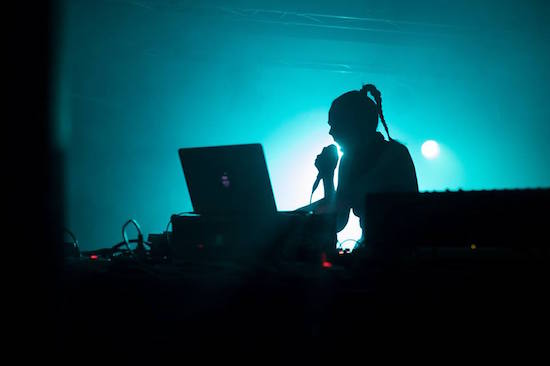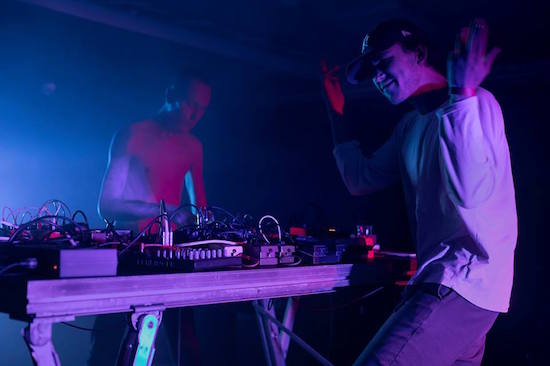Giant Swan photo by Aleš Rosa
Beyond Ljubljana’s cobbled riversides, dragon bridges and lurking human fish, Sonica festival celebrates its 10th birthday, filling the progressively crisp nights with experimental sound art and all-night raves in abandoned factories. From the haunting loops of Adam Basanta’s drowned tape installation Sunken Treasures to Tomoko Sauvage’s water acoustics and Giant Swan’s spirited bombardment of aggressive techno, the festival radiates immersive sensory stimulation.
You can emulate a cave-dwelling Slovenian amphibian and revel in your sensitivity
The ‘human fish’ – the eyeless olm salamander native to Ljubljana – is so sensitive to its environment that it feels its way through its 100 years with acute hearing and highly evolved senses. The theme of this year’s festival was over/sensitivity – from sensitivity in a wider political sense and the condition of the world, to the ethics of labour in music-making, to personal experience. To feel the vibrations of the various performances and installations travel through your feet, tremble around your heart and resonate into your bones is a metaphysical experience; it makes you feel akin, perhaps, to that human fish. In Sacred Horror In Design, Tarik Barri’s collaboration with Sote, the electronic element injected into the traditional Iranian music gives a distorted bassy depth like rolling thunder that reverberates through your body; while Barri’s haptic visuals allows your eyes into feel the texture of the images, giving them a physically sensory force.
As well as subtle knob-twiddling, slightly adjusting sliders and pointing microphones at unexpected places, electronic music performances can be utterly hypnotic
On Thursday night, a dimly lit room in the multi-arts centre Kino Šiška gradually fills with clusters of devoted electronic music fans. The crowd thickens and closes in on Lifecutter – Slovenian techno artist Domen Učakarja – as he bounds around his equipment and head-bangs to his heavy beats and distortions, crunching over his microphone with heavy-metal angst and working up a storm like Thor incarnate. Next up is Aïsha Devi, whose tempestuous supernatural soundscapes open up metaphysical channels as she undulates to crashing beats and waves of eerie sound. She layers her ritualistic vocal chants, as if communing with a world beyond our frequency, and occasionally breaks into a sublime smile.
Performance is even more powerful when the musician’s whole heart is in it
Jason Sharp wears a custom-built device that means his heart provides all the rhythmic textures of his performance with Adam Basanta. As Sharp played his huge bass saxophone, which fluctuated between resembling the deep boom of an approaching ocean liner and refracted waves of free jazz, the kick-drum was his heart in real time, while his amplified breathing sounded like the sea. I oscillated between the urge to close my eyes and feel the music, and the urge to see their source; sneaking a peak to see Adam swaying as he swapped out different receptacles to meticulously experiment with the feedback, and the force of Jason’s saxophone triggering the snare drum.

Aisha Devi photo by Aleš Rosa
Their abandoned factory raves are straight out of Blade
Eastern Europe has a banging underground scene headed up by women including, at Sonica: Ljubljana-based all-female DIY collective Kikimore, who used to throw ‘noise tea parties’; ČIPke workshops, who run electronic patchwork and labs for women only; electronic harp artist Rouge-Ah, who experiments with distortion and field-recordings; politically motivated feminist electronic duo Warrego Valles; and Slavic/gangster/geisha/pop musician Kukla. Ljubljana also has great, atmospheric, derelict spaces for showcasing these artists. It feels rare to be in a city that has these sorts of DIY havens, apparently untouched by regulations or property developers. There are whole complexes of abandoned grounds, where people sit on benches outside neglected buildings or around fires; space previously dominated by labour and mass-production is now being reclaimed by nature. Walking into the former factory where a techno-hungry throng was sweeping towards the DJs on the stage – the line-up including Alleged Witches, Actress, Lee Gamble and NinaBelle – I was immediately transported into the Wesley Snipes techno-sci-fi-vampire classic. I checked the ceiling for pipes, but the bloodbath never came.
William Basinski can take you to space
Iridescent in black sequins, the New York avant-garde artist William Basinski informed the audience that the evening would be a funeral mass for David Bowie. He briefly set the scene, elaborating that we would hear something akin to a New Orleans-esque marching band, before heading to the stars to search for the Starman himself. He told us to get comfortable, and checking around I realised this meant I could go fully horizontal. Brassy sounds like the blaring, worn tones of The Disintegration Loops series fired up a familiar, mournful Basinski sound. A distant rumbling increased, with snatches of a deteriorated saxophone riff trailing off, and all of a sudden we were in space. The floor was rumbling with the ship’s engine and the stars made dazzling patterns, as the sound of colliding matter echoed in the atmosphere like the muffled explosions of distant fireworks. A beautiful melody emerged through the shimmering synths of the Voyetra-8. The patterns of light on the ceiling felt like time dissolved and Basinski had us suspended in a singular moment; looping, transforming and transitory.
We need to decentralise power systems and fight for everyone’s rights
At one of Sonica’s roundtables produced with Shape Platform, cultural sociologist Ičo Vidmar talked about gentrification and the responsibilities of artists to be more sensitive and proactive about their impact on communities; “When you’re acting like a pioneer in immigrant and working class communities, you are socially not sensitive enough to be aware of what you’re doing. When artistic proletariat are doing things together and fighting with these communities to protect their rights, they are better.” Speaking about the publishing side of the music industry, founder of Subtext Recordings James Ginzburg pointed out that beyond the DIY approach, there are no ways of distributing music internationally without being part of exploitative, corporate things, and asked if there is a way to exist in society and not be complicit in exploitation. We have evolved into a distracted, predominantly inert, capitalist-fuelled civilisation, waiting for the powers that be to fix the broken system. They won’t. But if more people woke up and understood that we have political agency, we could.


